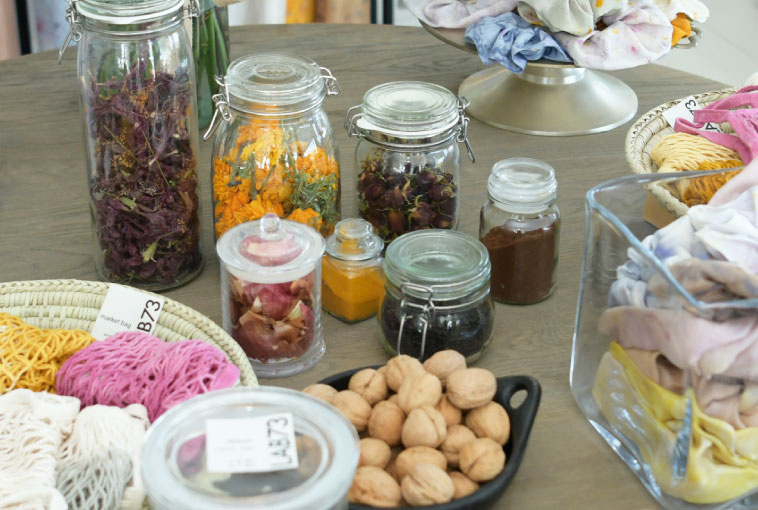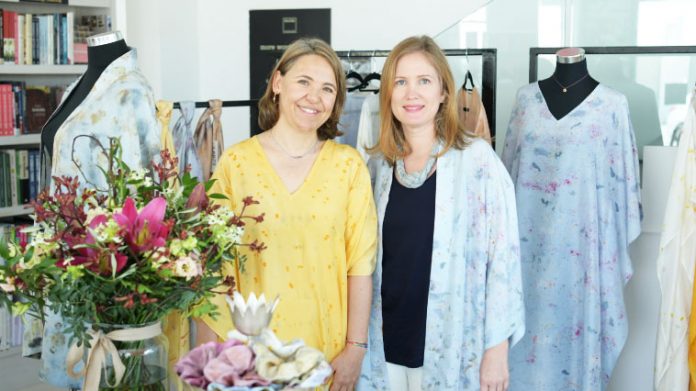When Lab73 started, around a year ago, yoga buddies and school mums Marie and Johanna didn’t have a name for it. “We realised that we’re both creative, like working with our hands and slowly but surely the idea of practising the age-old methods of hand dyeing fabrics grew,” says South African national, Marie. “Last summer, Johanna returned with a book from Sweden, and we started to learn and investigate ways to hand-dye cloth using plants in our garden.”
They had their first go on three metres of Indian silk given to them by a friend. Johanna says: “We were not satisfied with the outcome so we researched more. We learnt that dates were used to dye cloth in Bahrain. Traditional techniques in Sweden used alum for the colour to catch, while in Bahrain, salt was used for this purpose.”
After a lot of experimentation, Lab73 now retails naturally hand-dyed kaftans, kimonos, scrunchies, scarves, cloth bags and ribbons. The pair also do ‘eco-printing’, where petals are used to imprint their tints by using steam; a process called bundle dying. “This is ideal for brides wanting to save the memory of their wedding bouquet or anybody wanting to save special flowers,” says Johanna. “Colours of dark flowers like red roses can be transferred on to a scarf that can be used and passed down the generations.”
Explaining the dyeing process, which the duo carries out in Marie’s kitchen, Johanna says: “100-per-cent pure, white silk is first washed to rid it of any chemicals. Then it’s soaked in alum, which will allow it to absorb colour. Next, we soak it in the pigment we have made. It’s a bit like cooking actually!” Marie continues: “So if we want a blue shade, we boil cut-up red cabbage until we get the required intensity of the shade, strain the liquid and leave the fabric in it, stirring it regularly.”
Once the piece is dyed, it is ready to take on prints. Besides flowers, they use avocado rinds, onion peels, carrot leaves, turmeric, marigold, palm tree bark, henna, eucalyptus and cochineal for its red, purple or pink outcomes. “Hibiscus gives a lovely blue, while cabbage is very pH sensitive, so we can extract pink, purple and sometimes green from it,” Johanna says.
This procedure yields exclusive, one-of-a-kind pieces. Marie says: “Sometimes we try to recreate something that we like but the colours just come out differently. Also, different natural fabrics and their varying densities take on pigments differently.”
 Although the process is tedious and labour-intensive, the ladies are proud of its eco-friendly aspect. “This is the original way cloth was dyed before the mass production brought about by the Industrial Revolution. We use natural materials and kitchen waste. We also receive unwanted flowers from a florist, so nothing is really thrown away,” says Marie. “The idea is to buy something that you really love and use it for a long time. Naturally dyed garments can also be refreshed with more colour to give them new life, making it sustainable fashion.”
Although the process is tedious and labour-intensive, the ladies are proud of its eco-friendly aspect. “This is the original way cloth was dyed before the mass production brought about by the Industrial Revolution. We use natural materials and kitchen waste. We also receive unwanted flowers from a florist, so nothing is really thrown away,” says Marie. “The idea is to buy something that you really love and use it for a long time. Naturally dyed garments can also be refreshed with more colour to give them new life, making it sustainable fashion.”
Johanna explains: “We want more people to embrace the idea of slow fashion, wherein the process of creating fabrics is better appreciated. It’s about giving more value to your clothes, not just wearing them a few times before you discard them, and knowing that they have been made using non-toxic colours in environmentally friendly ways.”
Marie adds: “Both of us have become conscious of things like nature, the changing seasons and how we look at what we wear. Our tailors are all women who we pay fair wages to.
Consumers today need to think about who made their clothes and what has gone into making them. The fashion industry has a lot to answer for because of its impact on the planet. Responsible buyers and designers have the power to make a choice to offer and purchase sustainable items of value.”
You can find the ladies showing their creations at pop-up markets across the Kingdom.


































